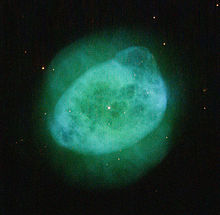astro.wikisort.org - Nebula
IC 289 is a planetary nebula in the constellation Cassiopeia.[3] It was discovered by Lewis Swift in early September 1888. It lies close to the 10th magnitude star BD +60° 0631. N.J. Martin described IC 289 as "A nice, faint round planet like planetary nebula. The uniform oval disc shows some irregularity in brightness but is not obviously brighter at the edge."[citation needed]
This article needs additional citations for verification. (April 2017) |
| Emission nebula | |
|---|---|
| Planetary nebula | |
 As seen by Hubble | |
| Observation data: J2000.0 epoch | |
| Right ascension | 03h 10m 19.3017s[1] |
| Declination | +61° 19′ 00.914″[1] |
| Distance | 5,190 ± 500 ly (1,592 ± 153 pc)[2] ly |
| Constellation | Cassiopeia |
| Designations | IRAS 03062+6107, 2MASS J03101930+6119009, ARO 86, Hb 1, VV 9, RL 67, Lan 496, NSV 1056, GSC2 N313033135782[1] |
The central star of the planetary nebula is an O-type star with a spectral type of O(H).[4]
References
- "IC 289". SIMBAD. Centre de données astronomiques de Strasbourg. Retrieved 2020-02-18.
- Brown, A. G. A.; et al. (Gaia collaboration) (August 2018). "Gaia Data Release 2: Summary of the contents and survey properties". Astronomy & Astrophysics. 616. A1. arXiv:1804.09365. Bibcode:2018A&A...616A...1G. doi:10.1051/0004-6361/201833051.
- IC 289
- González-Santamaría, I.; Manteiga, M.; Manchado, A.; Ulla, A.; Dafonte, C.; López Varela, P. (2021). "Planetary nebulae in Gaia EDR3: Central star identification, properties, and binarity". Astronomy & Astrophysics. 656: A51. arXiv:2109.12114. Bibcode:2021A&A...656A..51G. doi:10.1051/0004-6361/202141916. S2CID 237940344.
External links
 Media related to IC 289 at Wikimedia Commons
Media related to IC 289 at Wikimedia Commons- http://www.noao.edu/outreach/aop/observers/ic289.html
На других языках
[de] IC 289
IC 289 ist ein 4.200 Lichtjahre von der Erde entfernter Planetarischer Nebel im Sternbild Cassiopeia am Nordsternhimmel, der im Index-Katalog mit dem namensgebenden Akronym „IC“ verzeichnet ist. Der Nebel wurde am 2. September 1888 von dem US-amerikanischen Astronomen Lewis A. Swift entdeckt.[5]- [en] IC 289
Текст в блоке "Читать" взят с сайта "Википедия" и доступен по лицензии Creative Commons Attribution-ShareAlike; в отдельных случаях могут действовать дополнительные условия.
Другой контент может иметь иную лицензию. Перед использованием материалов сайта WikiSort.org внимательно изучите правила лицензирования конкретных элементов наполнения сайта.
Другой контент может иметь иную лицензию. Перед использованием материалов сайта WikiSort.org внимательно изучите правила лицензирования конкретных элементов наполнения сайта.
2019-2025
WikiSort.org - проект по пересортировке и дополнению контента Википедии
WikiSort.org - проект по пересортировке и дополнению контента Википедии